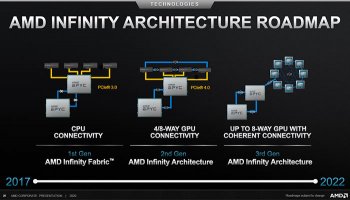the current Mac Pro Design makes no sense for Apple Silicon imo
if the point of Apple Silicon is to pull the Mac Pro to being more like a laptop, then yes. If Apple was going to try to do to the Mac line up what they do with iPhone and iPad Pro ( use one SoC die for the whole line up. ) then yes.
But that isn't necessarily the point of what the Mac Pro ( and iMac Pro and iMac 27" ) model really need. (Probably can throw in the 21-24" model. Maybe the Mac-Mini also. ). Supposedly, Apple does their own SoC for the leading edge products because they can adapt the SoC to what that specific product "needs". Now if look at the big picture of the Apple whole product line up there is far more "hand me down" of old iPhone/iPad Pro SoC to other products than making something maximally enhancing for each product.
The Mac Pro use-case that is driving the requirement for the numerous PCI-e slots isn't going to disappear with Apple Silicon (AS). iMac Pro and 27" iMac will probably still need a discrete GPU with x16 PCI-e v4 bandwidth capabilities.
MPX modules probably aren't going away on the Mac Pro. Neither is ECC RAM and triple (or quad ) digit GB capacities.
There are some synergies for many of the bundling of function units that the AS SoC has in the Mac Pro. First, at this point Thunderbolt 4 requires that there be video out for every port. Four ports on the current design means have a baseline need for 4 video streams. And iGPU present in the main SoC means that even if some user pulls every MPX GPU module from the system , the TBv4 ports would still meet certification.
Second, for the video vertical. Again having built in support for the widespread consumption video codes (e.g., H.265, H.264 , over time AV1 , etc. ) means it is just there regardless. For those workloads it is like having a built in afterburner card for those codecs without 'using up' a slot. (especially if the video fixed function IP and software stack is essentially 'paid for' but the volume usage on other AS/A-series variants. )
Apple doesn't have to put all of the GPU "horsepower" in the Mac Pro variant of AS. But "faar enough" for some minimal GPU baseline performance actually allows more options configurations that could those extra slot for something else. .
Third, the Mac Pro is at maximum standard wall socket power draw. If Apple can lower the CPU consumption budget max load, then they could handle bigger 'power hog' GPUs in a future system. If Apple can drop that 40-80W there it can be allocated to somewhere else since pragmatically in a 'zero sum' context at this point. (may be able to pull the SSD modules closer since not raining max temp air upon them. ) .
The Mac Pro AS SoC doesn't have to chase the "max core count" holy war into the > 32-64 core zone. Just has to be better Mac Pro than the current one. ( and on next iteration incrementally better relatively there too. ). If off in the zone that the Mac Pro has to have 64 , 72 , 128 cores to be "any good" as a workstation, then current Mac Pro design is not on that course at all. Shifting the "embarrassingly parallel" workloads to the GPU is primarily where it is pointing the future direction towards. Dropping in 'bigger/better' and multiple GPU modules/cards is primarily how that is addressed. Apple's general AS design lines work OK with that. It would need a different I/O subsystem but the general apps core subsystem and lowest common denominator GPU , Secure Enclave, Fixed function video, and Ai/ML tensor core combination isn't disconnected from the current Mac Pro at all.
it would need a much different I/O subsystem and much more beefy cache "system memory" . But that is somewhat of a add on ( with probably an enhanced internal communication bus(es). ) .
P.S. Would that future Mac Pro 'detach' from more of the general purpose workstation market? Yes. But it seems likely that all Macs with AS will 'detach' from all of the general purpose markets they inhabit. Not going to be limted to the Mac Pro. ( average selling price gap likely to increase. after sale configuration options. Even raw booting of other OS options. )
Last edited:







